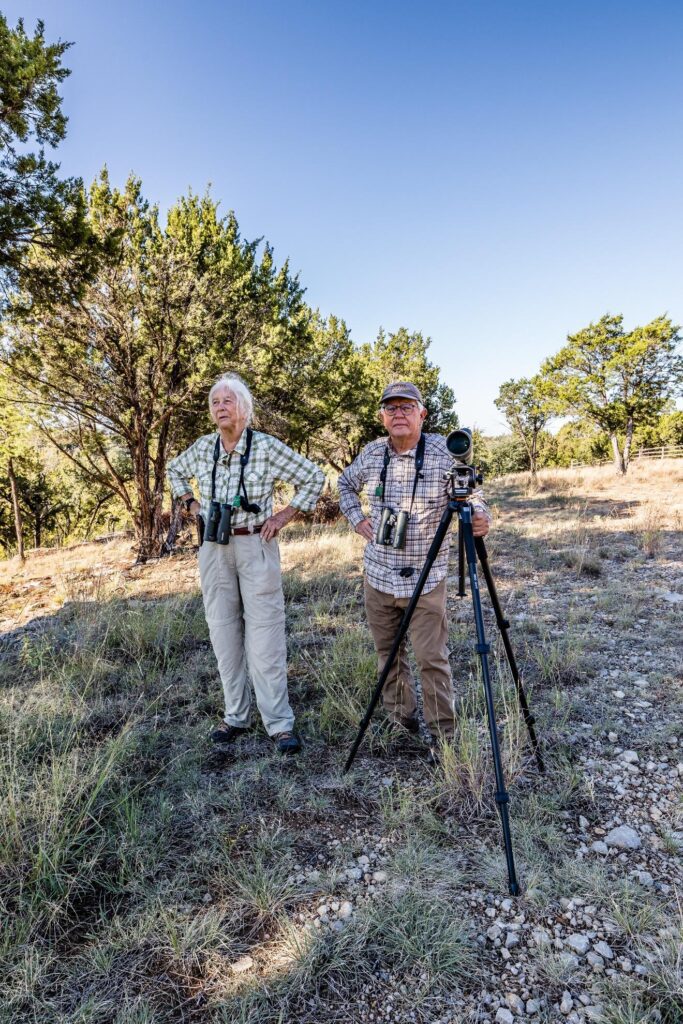Winter Wings
Story by Bob Kaspar | Photo by Erika Carter

Pictured above: Local PK residents Peter Gottschling, a retired chemist, and his wife, Lynne Aldrich, a retired hospital administrator, have been bird watching for 40 years.
The song of a cold winter morning on the Brazos River begins in time with the rising sun, heralded by the raspy, echoing call of a great blue heron. Soon thereafter, the tittering of killdeer fills the air as they chase one another across the sky, while ducks quack as they cup their wings to splash down calmly onto the river’s surface.
As summer gives way to fall, cooler temperatures bring thousands of winged winter visitors passing through during their annual fall migration.
Texas has more species of birds than any other state, with more than 600 identified in the state. Much of this biodiversity is due to Texas’ geography, being centrally located on the North American continent. It’s also the southern extent of many migratory birds’ range within the Central Flyway, a 9,000-mile-long zone of intense bird migration that runs from central Canada, across the Great Plains, and through Texas and Mexico to the tip of South America.
Twice a year, in the fall and spring, birds use this region as a migratory route. There is very little mountainous terrain along the flyway to impede the migrating birds, and many of them spend the winter on the Texas Gulf Coast or proceed farther to Central or South America.
During the fall migration, the abundant water supply of both Possum Kingdom Lake and the Brazos River provide attractive winter homes for numerous duck species. As the days get shorter, the ducks begin to accumulate fat and prepare for their migration south, and as their northern habitats begin to freeze, the birds fly south to more hospitable environments.
Blue-winged teal are among the first species to migrate, beginning their journey in early fall. They travel an incredibly long distance, with many of them ending up in South America. By September they can be seen dabbling in shallow pools along the Brazos River, and soon thereafter they’re joined by their cousin, the green-winged teal.
As the days get shorter, northern shovelers, mallards, widgeon, gadwall, bufflehead, wood ducks, bluebills and pintails, just to name a few, will spend some time at the lake, with more birds typically seen on colder days.
A few ducks, and especially geese, have become permanent residents of Possum Kingdom Lake, although this behavior is not fully understood. One theory is that habitats with abundant food and water, along with a lack of natural predators, tempts these birds to stay put.
There are numerous public access points to the Brazos River across Palo Pinto County, but the Brazos River Nature Trail offers ease of access along with unrivaled natural beauty. Visitors can park at either the Highway 16 bridge or at the Brazos River Authority Nature Park No. 7 off of Red Bluff Road, and a well-groomed nature trail connects the two parking areas. Closer to the Highway 16 end is a gravel canoe and kayak launch that offers unparalleled river access. This is an ideal area for an early morning excursion to see some waterfowl.
The nature trail also borders Possum Kingdom Fish Hatchery, which has 44 outdoor fish ponds, and the hatchery is an outstanding location to see ospreys during their fall migration. These large raptors boast a wingspan just under 6 feet, and they feed almost exclusively on fish. From the road they often can be seen hovering above the hatchery ponds before plunging feet first into the water to spear their prey with sharp talons.
Ospreys are one of the many migratory birds that Possum Kingdom resident and avid birdwatcher Peter Gottschling is always eager to see. His natural curiosity led him to birding years ago while living in Ohio.
“As a retired scientist, I just like learning about the things I don’t know,” he said.
This hunger for knowledge has taken him around the world and allowed him to see numerous rare bird species.
Birders such as Gottschling play a vital role in the study of bird populations. Biologists can’t track the movements of every bird, but Gottschling and other birders provide valuable data by cataloging their findings. That, in turn, allows biologists to make inferences about bird populations as a whole.
For anyone interested in birding, Gottschling suggested contacting a local Audubon Society.
“When you meet other birders, you learn a lot quicker than on your own,” he said.
Gottschling also recommended that new birders get a decent bird guide and dive into online sources such as the website eBird (https://ebird.org/home), offered by the Cornell Lab of Ornithology, which provides birders with real-time migratory reports, rare bird alerts, and an endless library of photos and sounds from multiple species.
Gottschling also suggested that budding birders take a keen interest in bird conservation.
“Cornell University has detected a significant decrease in bird populations in the past 50 years,” he said. “Much of this is driven by habitat loss.”
One easy way to help birds, Gottschling said, is through the Texas Audubon Society’s “Lights Out Texas” program. Significant mortality occurs when birds run into windows during evening flights, and the initiative asks participants to turn off non-essential lights from 11 p.m. to 6 a.m. during fall bird migrations (August through November). Houston and Dallas were ranked the No. 2 and No. 3 most dangerous cities in the country for light pollution during bird migration, and in 2017 an estimated 400 birds were killed during a single evening collision in Galveston. By turning off their lights at night, Texans can reduce urban light pollution and make the skies safer for the birds we love.

